Experimental Design Approach for Quantitative Expressions of Simultaneous Quantification of Two Binary Formulations Containing Remogliflozin and Gliptins by RP-HPLC
Abstract
1. Introduction
2. Materials and Methods
2.1. Reagents and Standards
2.2. Instrumentation and Chromatographic Condition
2.2.1. Box–Behnken Optimization Configuration
2.2.2. Optimized Chromatographic Configuration
2.2.3. Robustness Chromatographic Configuration
2.3. Preparation of Standard Solutions
2.4. Procedure for the Calibration Curve
2.5. Preparation of Sample Solutions
3. Results and Discussions
3.1. Optimization of Chromatographic Conditions
3.2. Validation of the Proposed HPLC Method
3.2.1. System Suitability Test
3.2.2. Linearity
3.2.3. Limits of Detection and Quantification
3.2.4. Precision and Accuracy
3.2.5. Robustness Study
3.3. Application to the Formulation and Recovery Study
4. Conclusions
Supplementary Materials
Author Contributions
Funding
Institutional Review Board Statement
Informed Consent Statement
Data Availability Statement
Acknowledgments
Conflicts of Interest
References
- Chatterjee, S.; Khunti, K.; Davies, M.J. Type 2 diabetes. Lancet 2017, 389, 2239–2251. [Google Scholar] [CrossRef]
- Mouhayyar, C.; Riachy, R.; Khalil, A.B.; Eid, A.; Azar, S. SGLT2 inhibitors, GLP-1 agonists, and DPP-4 inhibitors in diabetes and microvascular complications: A review. Int. J. Endocrinol. 2020, 2020, 1762164. [Google Scholar] [CrossRef] [PubMed]
- Cade, W.T. Diabetes-related microvascular and macrovascular diseases in the physical therapy setting. Phys. Ther. 2008, 88, 1322–1335. [Google Scholar] [CrossRef] [PubMed]
- Abdul-Ghani, M.A.; Puckett, C.; Triplitt, C.; Maggs, D.; Adams, J.; Cersosimo, E.A.; DeFronzo, R. Initial combination therapy with metformin, pioglitazone and exenatide is more effective than sequential add-on therapy in subjects with new-onset diabetes. Results from the Efficacy and Durability of Initial Combination Therapy for Type 2 Diabetes (EDICT). Diabetes Obes. Metab. 2015, 17, 268–275. [Google Scholar] [CrossRef]
- American Diabetes Association. 9. Pharmacologic approaches to glycemic treatment: Standards of medical care in diabetes-2020. Diabetes Care. 2020, 43, S98–S110. [Google Scholar] [CrossRef]
- Son, C.; Makino, H.; Kasahara, M.; Tanaka, T.; Nishimura, K.; Taneda, S.; Nishimura, T.; Kasama, S.; Ogawa, Y.; Miyamoto, Y.; et al. Comparison of efficacy between dipeptidyl peptidase-4 inhibitor and sodium–glucose cotransporter 2 inhibitor on metabolic risk factors in Japanese patients with type 2 diabetes mellitus: Results from the CANTABILE study. Diabetes Res. Clin. Pr. 2021, 180, 109037. [Google Scholar] [CrossRef] [PubMed]
- Ahsan, S. Abstract #1004069: Effectiveness of remogliflozin and vildagliptin combination in type 2 diabetes mellitus patients uncontrolled on triple oral drug therapy. Endocr. Pr. 2021, 27, S62. [Google Scholar] [CrossRef]
- Vella, A. Mechanism of Action of DPP-4 Inhibitors—New Insights. J. Clin. Endocrinol. Metab. 2012, 97, 2626–2628. [Google Scholar] [CrossRef] [PubMed]
- Mak, W.Y.; Nagarajah, J.R.; Halim, H.A.; Ramadas, A.; Pauzi, Z.M.; Pee, L.T.; Jagan, N. dipeptidyl peptidase-4 inhibitors use in type II diabetic patients in a tertiary hospital. J. Pharm. Policy Pr. 2020, 13, 1–8. [Google Scholar] [CrossRef]
- Baksh, S.N.; Segal, J.B.; McAdams-DeMarco, M.; Kalyani, R.R.; Alexander, G.C.; Ehrhardt, S. dipeptidyl peptidase-4 inhibitors and cardiovascular events in patients with type 2 diabetes, without cardiovascular or renal disease. PLoS ONE 2020, 15, e0240141. [Google Scholar] [CrossRef]
- Kawanami, D.; Takashi, Y.; Takahashi, H.; Motonaga, R.; Tanabe, M. Renoprotective effects of DPP-4 inhibitors. Antioxidants 2021, 10, 246. [Google Scholar] [CrossRef] [PubMed]
- Bhavadasan, K.; Davis, A.M.; Kolanthavel, B. Impact of dipeptidyl peptidase-4 inhibitors on glycemic control and Cardiovascular safety with adherence: An overview. Int. J. Diabetes Metab. 2019, 25, 90–99. [Google Scholar] [CrossRef]
- Li, X.; Huang, X.; Bai, C.; Qin, D.; Cao, S.; Mei, Q.; Ye, Y.; Wu, J. Efficacy and safety of teneligliptin in patients with type 2 diabetes mellitus: A systematic review and meta-analysis of randomized controlled trials. Front. Pharmacol. 2018, 9, 449. [Google Scholar] [CrossRef] [PubMed]
- Erande, S.; Sarwardekar, S.; Desai, B. QT/QTc safety and efficacy evaluation of teneligliptin in Indian type 2 diabetes mellitus patients: The “thorough QT/QTc” study (Q-SET study). Diabetes Metab. Syndr. Obes. 2019, 12, 961–967. [Google Scholar] [CrossRef] [PubMed]
- Joshi, S.S.; Singh, T.; Newby, D.E.; Singh, J. Sodium-glucose co-transporter 2 inhibitor therapy: Mechanisms of action in heart failure. Heart 2021, 107, 1032–1038. [Google Scholar] [CrossRef] [PubMed]
- Nelinson, D.S.; Sosa, J.M.; Chilton, R.J. SGLT2 inhibitors: A narrative review of efficacy and safety. J. Osteopat. Med. 2021, 121, 229–239. [Google Scholar] [CrossRef]
- Tentolouris, A.; Vlachakis, P.; Tzeravini, E.; Eleftheriadou, I.; Tentolouris, N. SGLT2 inhibitors: A review of their antidiabetic and cardioprotective effects. Int. J. Environ. Res. Public Health 2019, 16, 2965. [Google Scholar] [CrossRef]
- Bonora, B.M.; Avogaro, A.; Fadini, G.P. Extraglycemic Effects of SGLT2 Inhibitors: A review of the evidence. Diabetes, Metab. Syndr. Obes. 2020, 13, 161–174. [Google Scholar] [CrossRef]
- Scheen, A.J. Pharmacokinetic Characteristics and Clinical Efficacy of an SGLT2 inhibitor plus DPP-4 inhibitor combination therapy in type 2 diabetes. Clin. Pharmacokinet. 2017, 56, 703–718. [Google Scholar] [CrossRef]
- Lingvay, I. Sodium glucose cotransporter 2 and Dipeptidyl Peptidase-4 inhibition: Promise of a dynamic duo. Endocr. Pr. 2017, 23, 831–840. [Google Scholar] [CrossRef]
- Attimarad, M.; Venugopala, K.; Sreeharsha, N.; Chohan, M.; Shafi, S.; Nair, A.; Pottathil, S. A rapid HPLC method for the concurrent determination of several antihypertensive drugs from binary and ternary formulations. Separations 2021, 8, 86. [Google Scholar] [CrossRef]
- Sigafoos, J.F.; Bowers, G.D.; Castellino, S.; Culp, A.G.; Wagner, D.S.; Reese, M.J.; Humphreys, J.E.; Hussey, E.K.; Semmes, R.L.O.; Kapur, A.; et al. Assessment of the drug interaction risk for remogliflozin etabonate, a sodium-dependent glucose cotransporter-2 inhibitor: Evidence from in vitro, human mass balance, and ketoconazole interaction studies. Drug Metab. Dispos. 2012, 40, 2090–2101. [Google Scholar] [CrossRef] [PubMed]
- Attimarad, M.; Nair, A.; Sreeharsha, N.; Al-Dhubiab, B.; Venugopala, K.; Shinu, P. Development and validation of green uv derivative spectrophotometric methods for simultaneous determination metformin and remogliflozin from formulation: Evaluation of greenness. Int. J. Environ. Res. Public Heal. 2021, 18, 448. [Google Scholar] [CrossRef] [PubMed]
- Attimarad, M.; Elgorashe, R.E.E.; Subramaniam, R.; Islam, M.M.; Venugopala, K.N.; Nagaraja, S.; Balgoname, A.A. Development and validation of rapid RP-HPLC and green second-derivative UV spectroscopic methods for simultaneous quantification of metformin and remogliflozin in formulation using experimental design. Separations 2020, 7, 59. [Google Scholar] [CrossRef]
- Tayade, A.B.; Patil, A.S.; Shirkhedkar, A.A. Development and validation of zero order uv-spectrophotometric method by area under curve technique and high performance thin layer chromatography for the estimation of remogliflozin etabonate in bulk and in-house tablets. Invent. Rapid Pharm. Anal. Qual. Assur. 2019, 3, 1–5. [Google Scholar]
- Bhatkar, T.; Badkhal, A.V.; Bhajipale, N.S. stability indicating rp-hplc method development and validation for the esti-mation of remogliflozin etabonate in bulk and pharmaceutical dosage form. Int. J. Pharmace. Res. 2020, 12, 4197–4207. [Google Scholar] [CrossRef]
- Shah, D.; Gondalia, I.; Patel, V.; Mahajan, A.; Chhalotiya, U.K. Stability indicating liquid chromatographic method for the estimation of remogliflozin etabonate. J. Chem. Metrol. 2020, 14, 125–132. [Google Scholar] [CrossRef]
- Tammisetty, M.R.; Challa, B.R.; Puttagunta, S.B. A Novel Analytical Method for the Simultaneous Estimation of Remogliflozin and Metformin Hydrochloride by UPLC/PDA in Bulk and Formulation Application to the Estimation of Product Traces. Turk. J. Pharm. Sci. 2021, 18, 296–305. [Google Scholar] [CrossRef]
- Dayoub, L.A.; Amali, F. Development of a new visible Spectrophotometric analytical method for determination of Vildagliptin in bulk and Pharmaceutical dosage forms. Res. J. Pharm. Technol. 2020, 13, 2807. [Google Scholar] [CrossRef]
- Kumari, B.; Khansili, A. Analytical Method Development and Validation of UV-visible Spectrophotometric Method for the Estimation of Vildagliptin in Gastric Medium. Drug Res. 2020, 70, 417–423. [Google Scholar] [CrossRef]
- Giordani, C.F.A.; Campanharo, S.C.; Wingert, N.R.; Bueno, L.M.; Manoel, J.W.; Garcia, C.V.; Volpato, N.M.; Iop, G.D.; Mello, P.D.A.; Flores, E.M.D.M.; et al. UPLC-ESI/Q-TOF MS/MS method for determination of vildagliptin and its organic impurities. J. Chromatogr. Sci. 2020, 58, 718–725. [Google Scholar] [CrossRef]
- Abdel-Ghany, M.F.; Abdel-Aziz, O.; Ayad, M.F.; Tadros, M.M. Validation of different spectrophotometric methods for determination of vildagliptin and metformin in binary mixture. Acta. A Mole Biomole Spectro. 2014, 125, 175–182. [Google Scholar] [CrossRef]
- Moneeb, M.S. Spectrophotometric and spectrofluorimetric methods for the determination of saxagliptin and vildagliptin in bulk and pharmaceutical preparations. Bull. Fac. Pharm Cairo Uni. 2013, 51, 139–150. [Google Scholar] [CrossRef][Green Version]
- Altunkaynak, Y.; Yavuz, Ö.; Levent, A. Firstly electrochemical examination of vildagliptin at disposable graphite sensor: Sensitive determination in drugs and human urine by square-wave voltammetry. Microchem. J. 2021, 170, 106653. [Google Scholar] [CrossRef]
- Shakoor, A.; Ahmed, M.; Ikram, R.; Hussain, S.; Tahir, A.; Jan, B.M.; Adnan, A. Stability-indicating RP-HPLC method for simultaneous determination of metformin hydrochloride and vildagliptin in tablet and biological samples. Acta Chromtogr. 2020, 32, 39–43. [Google Scholar] [CrossRef]
- Sen, A.; Hinsu, D.; Sen, D.; Zanwar, A.; Maheshwari, R.; Chandrakar, V. Analytical method development and validation for simultaneous estimation of Teneligliptin hydrobromide hydrate and Metformin hydrochloride from it’s pharmaceutical dosage form by three different UV spectrophotometric methods. J. Appl. Pharm. Sci. 2016, 6, 157–165. [Google Scholar] [CrossRef]
- Joshi, H.; Khristi, A. Absorbance ratio method development and validation for the simultaneous estimation of teneligliptin hydrobromide hydrate and metformin hydrochloride in tablet dosage form. Int. Res. J. Pharm. 2018, 9, 47–55. [Google Scholar] [CrossRef]
- Chitlange, S.S.; Rawat, D.G.; Gandhi, S.P. Estimation of anti diabetic teneligliptin in bulk and formulation by densitometric and spectrophotometric method. Anal. Chem. Lett. 2017, 7, 556–566. [Google Scholar] [CrossRef]
- Shaikh, A.R.; Ahmed, B.A.R.K.; Ibrahim, M. A validated stability indicating RP-HPLC method for simultaneous estimation of metformin and teneligliptin in bulk and pharmaceutical dosage form. Int. J. Pharm. Sci. Res. 2018, 9, 1705–1712. [Google Scholar] [CrossRef]
- Mrunal, C.S.; Annapurna, M.M. Simultaneous determination of metformin and teneligliptin by liquid chromatography in tablets. As. J. Pharmaceu. 2018, 12, 736–739. [Google Scholar] [CrossRef]
- Vetapalem, R.; Yejella, R.P.; Atmakuri, L.R. Development and validation of a stability indicating rp-hplc method for simultaneous estimation of teneligliptin and metformin. Turk. J. Pharm. Sci. 2020, 17, 141–147. [Google Scholar] [CrossRef]
- Kumar, T.N.V.G.; Vidyadhara, S.; Narkhede, N.A.; Silpa, Y.S.; Lakshmi, M.R. Method development, validation, and stability studies of teneligliptin by RP-HPLC and identification of degradation products by UPLC tandem mass spectroscopy. J. Anal. Sci. Technol. 2016, 7, 27. [Google Scholar] [CrossRef][Green Version]
- Park, J.; Kim, K.; Park, J. Development of a liquid chromatography/tandem-mass spectrometry assay for the simultaneous determination of teneligliptin and its active metabolite teneligliptin sulfoxide in human plasma. Biomed. Chromatogr. 2020, 34, e4721. [Google Scholar] [CrossRef]
- Attimarad, M.; Venugopala, K.N.; SreeHarsha, N.; Aldhubiab, B.E.; Nair, A.B. Validation of rapid RP-HPLC method for concurrent quantification of amlodipine and celecoxib in pure and formulation using an experimental design. Microchem. J. 2020, 152, 104365. [Google Scholar] [CrossRef]
- Sahu, P.K.; Ramisetti, N.R.; Cecchi, T.; Swain, S.; Patro, C.S.; Panda, J. An overview of experimental designs in HPLC method development and validation. J. Pharm. Biomed. Anal. 2018, 147, 590–611. [Google Scholar] [CrossRef] [PubMed]
- Awotwe-Otoo, D.; Agarabi, C.; Faustino, P.J.; Habib, M.J.; Lee, S.; Khan, M.; Shah, R.B. Application of quality by design elements for the development and optimization of an analytical method for protamine sulfate. J. Pharm. Biomed. Anal. 2012, 62, 61–67. [Google Scholar] [CrossRef] [PubMed]
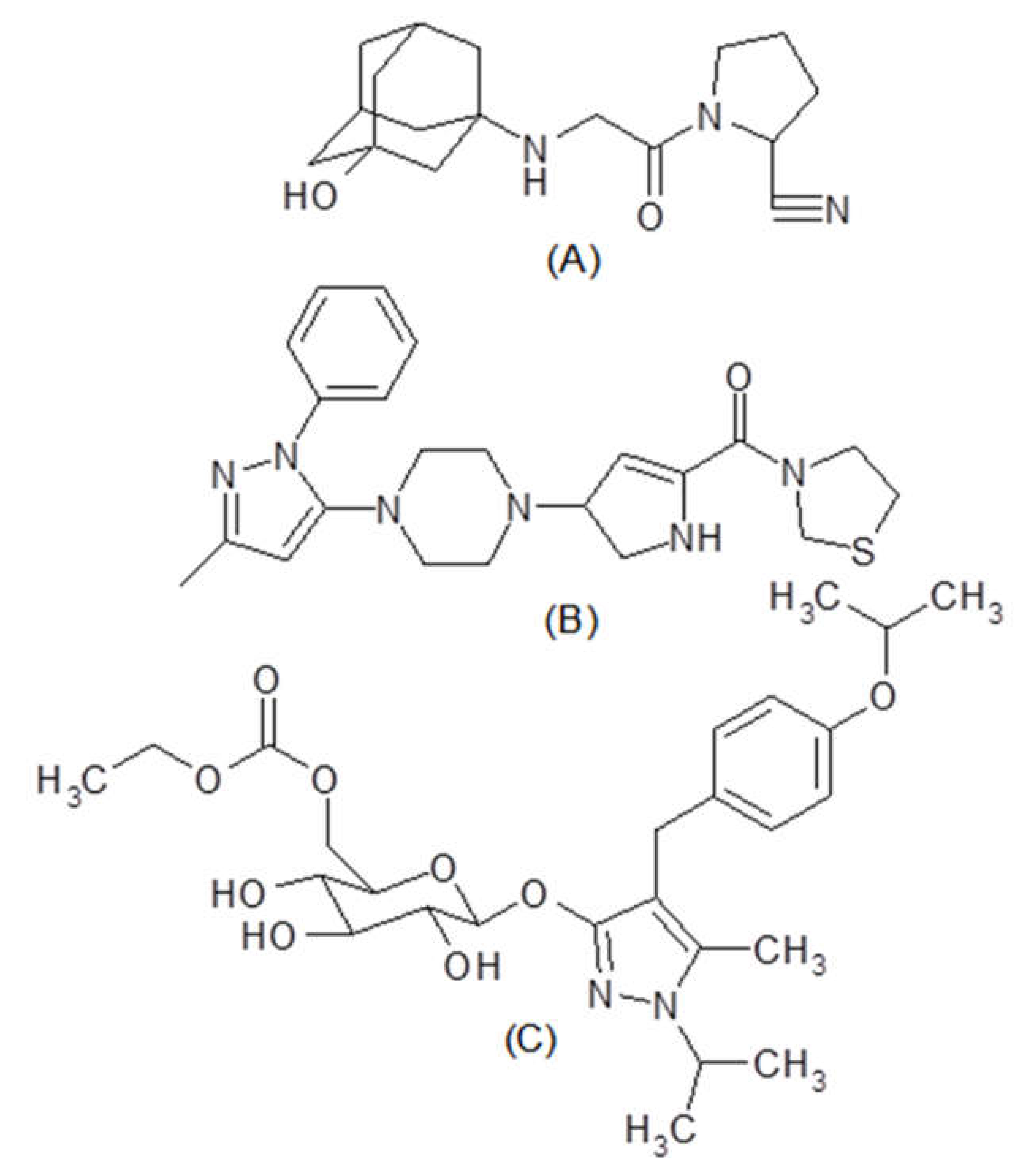
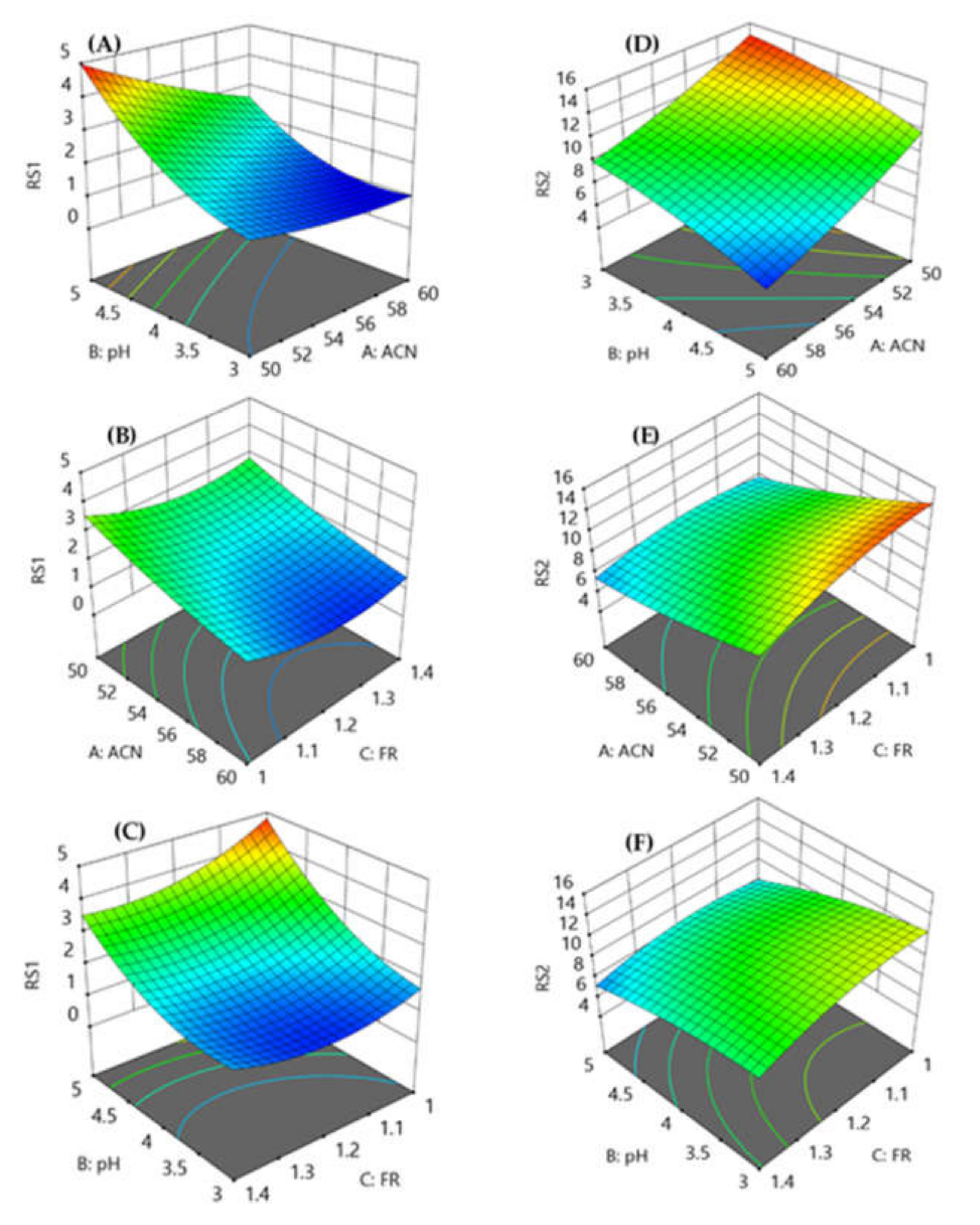
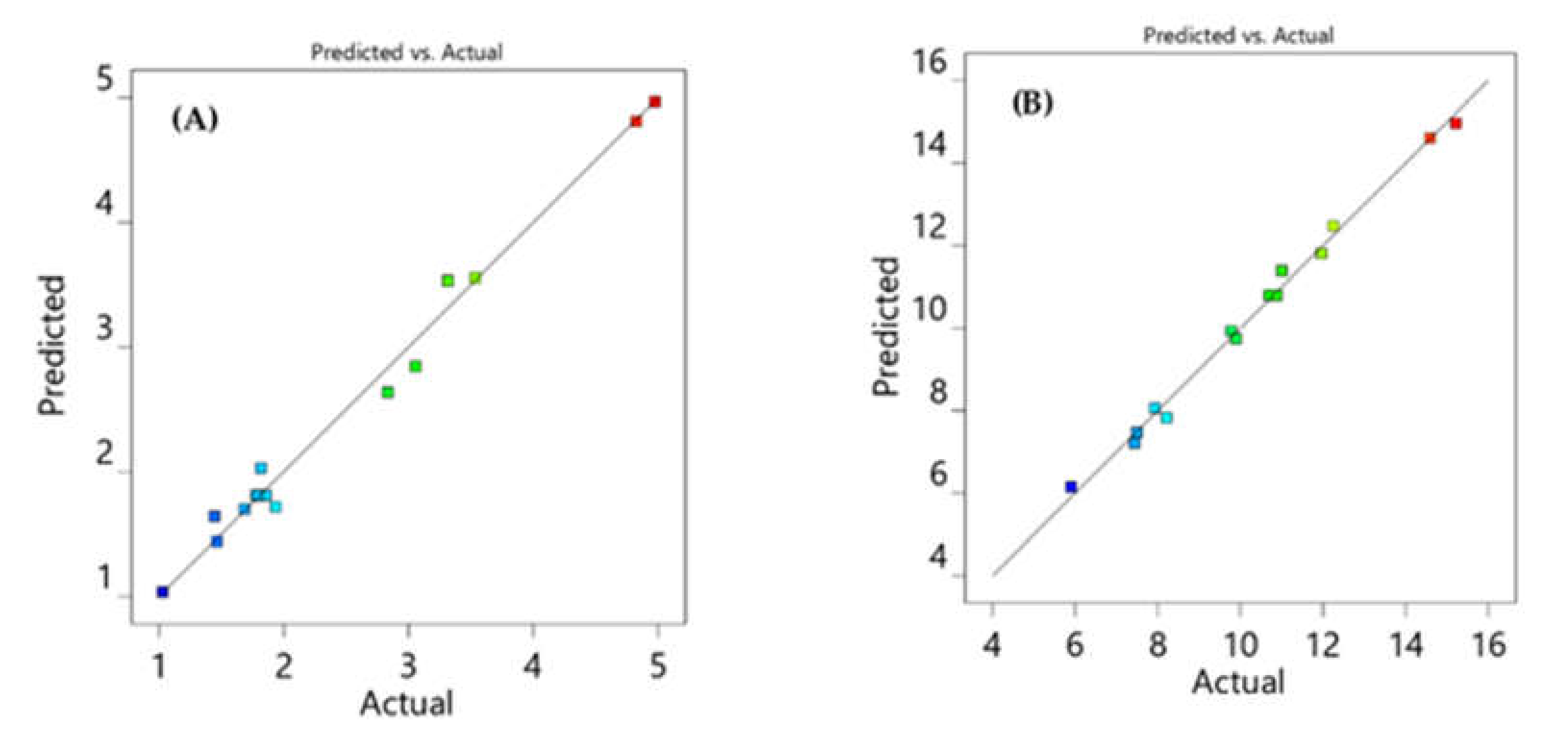
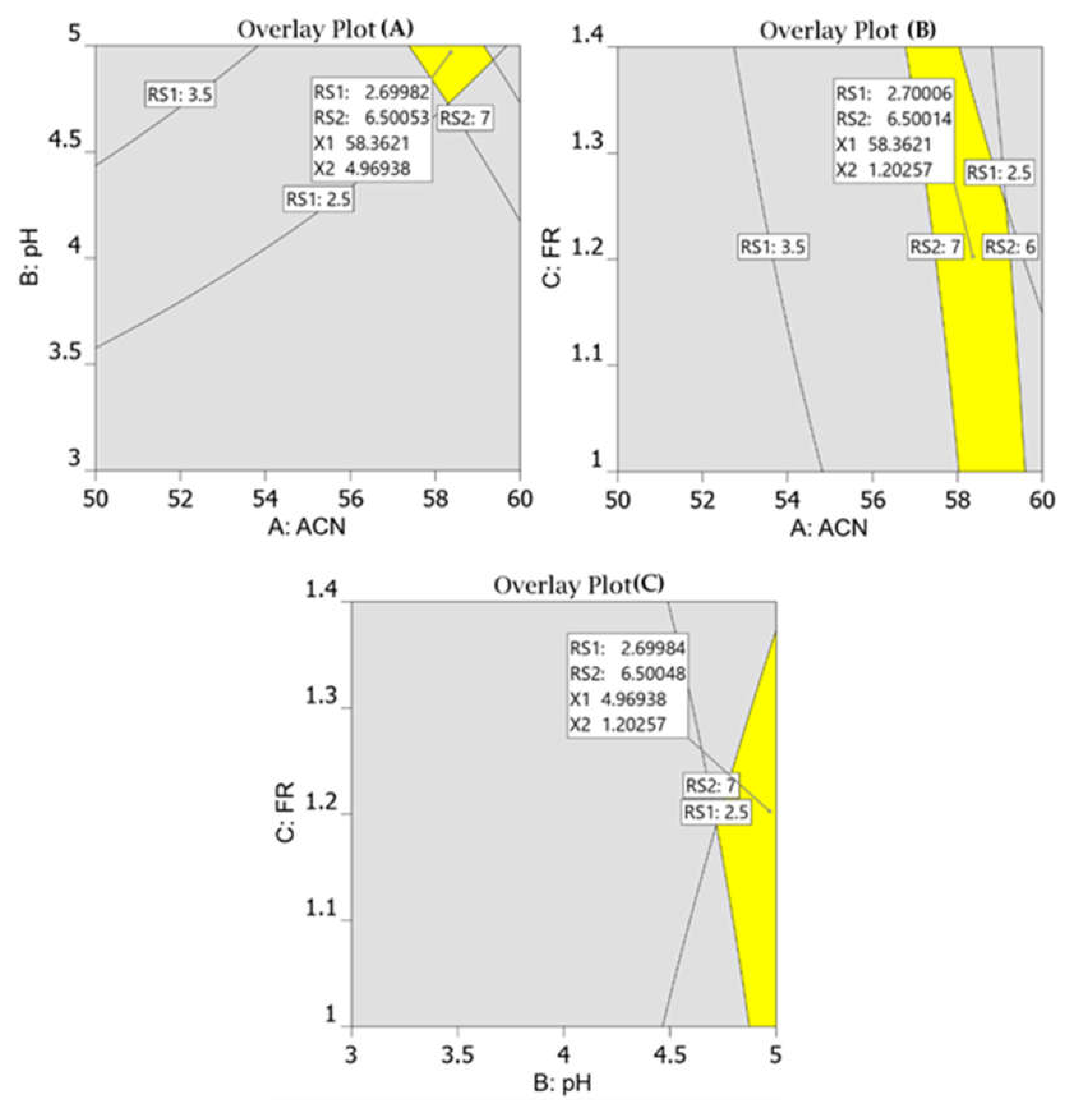
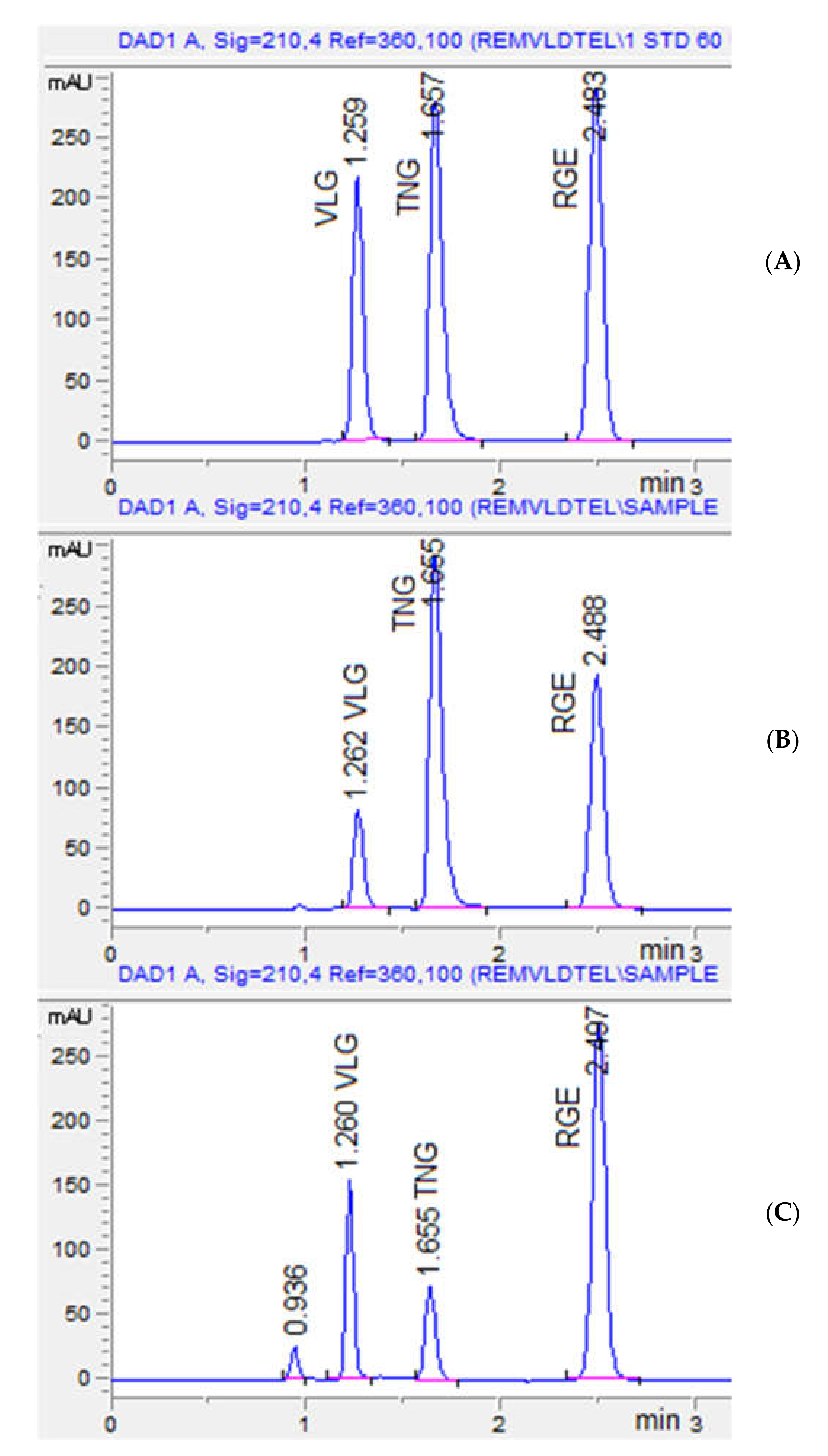
| Pattern | Factor 1 | Factor 2 | Factor 3 | Resolution between VLG and TNG | Resolution between TNG and RGE | |
|---|---|---|---|---|---|---|
| Coded Value | Run | A: % of Acetonitrile | B: pH | C: flow Rate mL min−1 | ||
| 0 0 0 | 3 | 55 | 4 | 1.2 | 1.81 | 10.80 |
| 0 0 0 | 5 | 55 | 4 | 1.2 | 1.79 | 10.87 |
| 0 0 0 | 6 | 55 | 4 | 1.2 | 1.78 | 10.88 |
| 0 0 0 | 10 | 55 | 4 | 1.2 | 1.86 | 10.70 |
| 0 0 0 | 11 | 55 | 4 | 1.2 | 1.81 | 10.76 |
| − − 0 | 14 | 50 | 3 | 1.2 | 1.44 | 15.22 |
| − + 0 | 7 | 50 | 5 | 1.2 | 4.98 | 11.96 |
| − 0 − | 13 | 50 | 4 | 1.0 | 3.54 | 14.59 |
| − 0 + | 15 | 50 | 4 | 1.4 | 3.06 | 11.00 |
| 0 − − | 9 | 55 | 3 | 1.0 | 1.93 | 12.25 |
| 0 − + | 2 | 55 | 3 | 1.4 | 1.68 | 9.89 |
| 0 + − | 4 | 55 | 5 | 1.0 | 4.83 | 7.93 |
| 0 + + | 17 | 55 | 5 | 1.4 | 3.31 | 7.44 |
| + 0 + | 12 | 60 | 4 | 1.4 | 1.46 | 7.49 |
| + + 0 | 8 | 60 | 5 | 1.2 | 2.83 | 5.90 |
| + − 0 | 1 | 60 | 3 | 1.2 | 1.03 | 9.78 |
| + 0 − | 16 | 60 | 4 | 1.0 | 1.82 | 8.21 |
| Coefficient Terms | Resolution between VLG and TNG (RS1) | Resolution between TNG and RGE (RS2) | ||
|---|---|---|---|---|
| Coefficient Value | p-Value | Coefficient Value | p-Value | |
| Constant | 1.81 | <0.0001 | 10.80 | <0.0001 |
| CAN a | −0.7338 | 0.0001 | −2.67 | 0.0001 |
| pH | 1.23 | 0.0001 | −1.74 | 0.0001 |
| Flow rate | −0.3243 | 0.0022 | −0.8956 | 0.0001 |
| CAN * pH | −0.4316 | 0.0030 | −0.1556 | 0.3338 |
| CAN * Flow rate | 0.0312 | 0.0758 | 0.7168 | 0.0020 |
| pH * Flow rate | −0.3153 | 0.0143 | 0.4685 | 0.0167 |
| CAN * ACN | 0.1448 | 0.1712 | 0.4304 | 0.0215 |
| pH * pH | 0.6168 | 0.0003 | −0.5187 | 0.0093 |
| Flow rate * Flow rate | 0.5143 | 0.0010 | −0.9078 | 0.0004 |
| Parameters | VLG | RGE | TNG | RGE |
|---|---|---|---|---|
| System Suitability Results | ||||
| Retention time ± SD | 1.26 ± 0.015 | 2.48 ± 0.021 | 1.65 ± 0.019 | 2.48 ± 0.021 |
| Peak area ± SD | 309.82 ± 3.18 a | 885.35 ± 2.86 b | 722.95 ± 2.54 c | 885.35 ± 2.86 |
| Resolution ± SD | -- | 6.48 ± 0.14 d | 2.79 ± 0.05 e | 6.48 ± 0.14 |
| Tailing factor ± SD | 0.99 ± 0.02 | 1.08 ± 0.02 | 1.16 ± 0.03 | 1.08 ± 0.02 |
| Theoretical plate ± SD | 2437.6 ± 21.4 | 3388.9 ± 28.1 | 5855.7 ± 44.5 | 3388.9 ± 28.1 |
| Linearity | ||||
| Linearity range (µg mL−1) | 5–100 | 5–100 | 2–60 | 5–100 |
| Slope | 0.0107 | 0.0164 | 0.0692 | 0.0351 |
| Intercept | 0.003 | 0.0054 | 0.2864 | −0.0237 |
| Regression coefficient (r2) | 0.9997 | 0.9996 | 0.9989 | 0.9999 |
| Sensitivity | ||||
| LOD (µg mL−1) | 1.46 | 1.39 | 0.56 | 1.39 |
| LOQ (µg mL−1) | 4.52 | 4.10 | 1.64 | 4.10 |
| Drug | Inter-Day | Intra-Day | |||||||
|---|---|---|---|---|---|---|---|---|---|
| Amount [µg mL−1] | Amount Found Mean [n = 3] ± SD | % RSD | % Recovery | % RE | Amount found Mean [n = 9] ± SD | % RSD | % Recovery | % RE | |
| VLG | 5 | 04.98 ± 0.03 | 0.60 | 99.60 | −0.40 | 05.01 ± 0.04 | 0.80 | 100.20 | 0.20 |
| 50 | 49.25 ± 0.67 | 1.36 | 98.50 | −1.50 | 49.09 ± 0.37 | 0.75 | 98.18 | −1.82 | |
| 100 | 99.48 ± 1.26 | 1.27 | 99.48 | −0.52 | 98.51 ± 1.19 | 1.21 | 98.51 | −1.49 | |
| RGE | 5 | 04.97 ± 0.05 | 1.01 | 99.40 | −0.60 | 05.02 ± 0.07 | 1.39 | 100.40 | 0.40 |
| 50 | 49.09 ± 0.63 | 1.28 | 98.18 | −1.82 | 50.26 ± 0.83 | 1.65 | 100.52 | 0.52 | |
| 100 | 99.18 ± 0.82 | 0.83 | 99.18 | −0.82 | 101.06 ± 1.27 | 1.26 | 101.06 | 1.06 | |
| TNG | 2 | 02.03 ± 0.02 | 0.99 | 101.50 | 1.50 | 01.97 ± 0.02 | 1.02 | 98.50 | −1.50 |
| 30 | 29.66 ± 0.45 | 1.52 | 98.87 | −1.13 | 29.58 ± 0.36 | 1.22 | 98.60 | −1.40 | |
| 60 | 58.93 ± 0.53 | 0.90 | 98.22 | −1.78 | 59.12 ± 0.84 | 1.42 | 98.53 | −1.47 | |
| RGE | 5 | 04.96 ± 0.06 | 1.21 | 99.20 | −0.80 | 05.04 ± 0.08 | 1.59 | 100.80 | 0.80 |
| 50 | 50.16 ± 0.75 | 1.50 | 100.32 | 0.32 | 49.36 ± 0.39 | 0.79 | 98.72 | −1.28 | |
| 100 | 100.24 ± 1.48 | 1.48 | 100.24 | 0.24 | 98.78 ± 0.93 | 0.94 | 98.78 | −1.22 | |
| Parameters | Levels | Peak Area | ||||
|---|---|---|---|---|---|---|
| VLG | TNG | RGE | RS1 | RS2 | ||
| Flow Rate (mL min−1) | ||||||
| 1.1 | −0.1 | 359.24 ± 3.45 | 1325.73 ± 10.24 | 568.24 ± 5.48 | 2.75 | 6.44 |
| 1.2 | 0 | 354.18 ± 4.28 | 1316.37 ± 09.78 | 554.45 ± 6.24 | 2.78 | 6.47 |
| 1.3 | +0.1 | 349.89 ± 3.74 | 1307.90 ± 11.46 | 541.97 ± 5.69 | 2.80 | 6.51 |
| Percentage of Acetonitrile in Mobile Phase (mL) | ||||||
| 56 | −2 | 360.12 ± 4.54 | 1331.17 ± 12.48 | 563.72 ± 5.32 | 2.81 | 6.52 |
| 58 | 0 | 353.58 ± 3.77 | 1315.49 ± 12.09 | 549.38 ± 5.68 | 2.79 | 6.45 |
| 60 | +2 | 352.36 ± 3.09 | 1310.67 ± 10.37 | 537.88 ± 6.45 | 2.74 | 6.43 |
| pH of the Mobile Phase | ||||||
| 4.7 | −0.2 | 352.45 ± 3.61 | 1320.82 ± 9.28 | 542.97 ± 6.08 | 2.77 | 6.45 |
| 4.9 | 0 | 355.72 ± 3.96 | 1318.57 ± 10.55 | 550.46 ± 5.43 | 2.78 | 6.48 |
| 5.1 | +0.2 | 347.13 ± 4.86 | 1308.38 ± 11.95 | 543.54 ± 7.83 | 2.75 | 6.47 |
| Injection Volume (µL) | ||||||
| 19 | −1 | 342.18 ± 4.07 | 1304.27 ± 12.47 | 540.24 ± 7.25 | 2.75 | 6.43 |
| 20 | 0 | 356.73 ± 3.81 | 1320.17 ± 11.39 | 552.37 ± 6.13 | 2.77 | 6.46 |
| 21 | +1 | 364.99 ± 3.46 | 1326.45 ± 10.08 | 562.42 ± 6.04 | 2.78 | 6.48 |
| Wavelength (nm) | ||||||
| 208 | −2 | 367.54 ± 4.25 | 1324.29 ± 11.23 | 564.39 ± 5.31 | 2.76 | 6.49 |
| 210 | 0 | 357.15 ± 3.28 | 1318.44 ± 10.05 | 558.77 ± 6.29 | 2.79 | 6.45 |
| 212 | +2 | 341.56 ± 4.22 | 1302.36 ± 11.53 | 542.54 ± 5.78 | 2.81 | 6.47 |
| F (3.478) a | 0.092 | 0.989 | 0.374 | 0.373 | 0.123 | |
| Label Claim (mg/Tab) | Amount Taken (µg mL−1) | Amount Found (µg mL−1) | Recovery % | % RSD |
|---|---|---|---|---|
| Formulation 1 (VGE 50 mg+ RGE 100 mg) | VLG 20 RGE 40 | 19.75 39.68 | 98.75 99.20 | 0.60 1.62 |
| Recovery study by Standard Addition Method | ||||
| Amount of VGE added (µg mL−1) to formulation solution 1 | 10 | 10.06 | 100.60 | 1.08 |
| 20 | 19.63 | 98.15 | 0.85 | |
| 30 | 29.82 | 99.40 | 1.53 | |
| Amount of RGE added (µg mL−1) to formulation solution 1 | 20 | 19.78 | 98.90 | 1.82 |
| 40 | 39.86 | 99.65 | 1.27 | |
| 60 | 58.91 | 98.18 | 0.92 | |
| Formulation 2 (TNG 10 mg + RGE100 mg) | TNG 4 RGE 40 | 3.97 39.54 | 99.25 98.85 | 1.15 0.96 |
| Recovery Study by Standard Addition Method | ||||
| Amount of TNG added (µg mL−1) to formulation solution 2 | 2 | 2.01 | 100.50 | 1.82 |
| 4 | 3.96 | 99.00 | 1.26 | |
| 6 | 5.93 | 98.83 | 1.33 | |
| Amount of RGE added (µg mL−1) to formulation solution 2 | 20 | 20.08 | 100.40 | 1.17 |
| 40 | 39.82 | 99.55 | 0.94 | |
| 60 | 59.67 | 99.45 | 1.06 | |
Publisher’s Note: MDPI stays neutral with regard to jurisdictional claims in published maps and institutional affiliations. |
© 2022 by the authors. Licensee MDPI, Basel, Switzerland. This article is an open access article distributed under the terms and conditions of the Creative Commons Attribution (CC BY) license (https://creativecommons.org/licenses/by/4.0/).
Share and Cite
Attimarad, M.; Venugopala, K.N.; Nair, A.B.; Sreeharsha, N.; Deb, P.K. Experimental Design Approach for Quantitative Expressions of Simultaneous Quantification of Two Binary Formulations Containing Remogliflozin and Gliptins by RP-HPLC. Separations 2022, 9, 23. https://doi.org/10.3390/separations9020023
Attimarad M, Venugopala KN, Nair AB, Sreeharsha N, Deb PK. Experimental Design Approach for Quantitative Expressions of Simultaneous Quantification of Two Binary Formulations Containing Remogliflozin and Gliptins by RP-HPLC. Separations. 2022; 9(2):23. https://doi.org/10.3390/separations9020023
Chicago/Turabian StyleAttimarad, Mahesh, Katharigatta Narayanaswamy Venugopala, Anroop Balachandran Nair, Nagaraja Sreeharsha, and Pran Kishore Deb. 2022. "Experimental Design Approach for Quantitative Expressions of Simultaneous Quantification of Two Binary Formulations Containing Remogliflozin and Gliptins by RP-HPLC" Separations 9, no. 2: 23. https://doi.org/10.3390/separations9020023
APA StyleAttimarad, M., Venugopala, K. N., Nair, A. B., Sreeharsha, N., & Deb, P. K. (2022). Experimental Design Approach for Quantitative Expressions of Simultaneous Quantification of Two Binary Formulations Containing Remogliflozin and Gliptins by RP-HPLC. Separations, 9(2), 23. https://doi.org/10.3390/separations9020023









